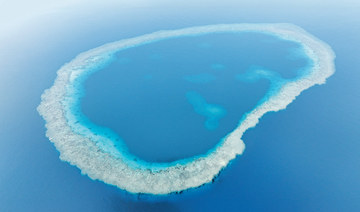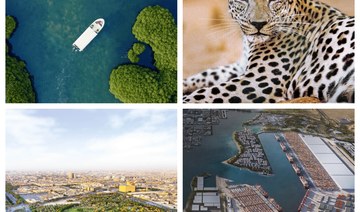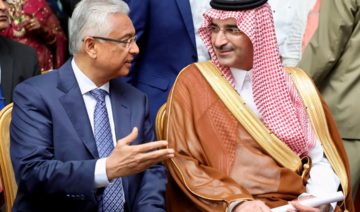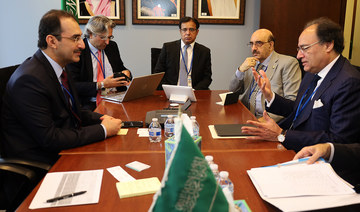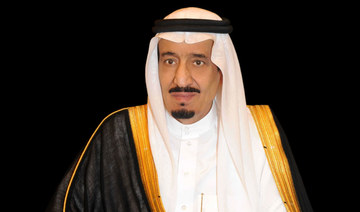MOSCOW: Russian President Vladimir Putin hosted Saudi Arabia’s King Salman for talks at the Kremlin on Thursday, cementing a relationship that is pivotal for world oil prices and could decide the outcome of the conflict in Syria.
Putin received the monarch in the gold-decorated St. Andrew Hall, one of the grandest spaces in the Kremlin, attended by soldiers in ceremonial dress and with an orchestra playing their countries’ national anthems.
“I am sure that your visit will provide a good impulse for the development of relations between our two states,” Putin told King Salman as they sat alongside each other in the Kremlin’s lavishly decorated Green Parlor. “This is the first visit by a Saudi monarch in the history of our relations and that in itself is a landmark event,” Putin said.
The king invited Putin to visit his country — an offer the Russian leader accepted — and said they planned to keep cooperating to keep world oil prices stable.
King Salman told Putin that Iran must stop meddling in the Middle East, Russia’s Interfax news agency reported.
“We emphasize that the security and stability of the Gulf region and the Middle East is an urgent necessity for achieving stability and security in Yemen,” the king said.
“This would demand that Iran give up interference with the internal affairs of the region, to give up actions destabilizing the situation in this region.”
Saudi Foreign Minister Adel Al-Jubeir told journalists that “relations between Russia and Saudi Arabia have reached a historic moment.”
King Salman and President Putin signed a slew of arms and energy deals.
Saudi Arabia signed preliminary agreements to buy Russia’s S-400 air defense systems and anti-tank guided missile systems and receive “cutting-edge technologies,” the state-owned Saudi Arabian Military Industries (SAMI) said.
These agreements are “expected to play a pivotal role in the growth and development of the military and military systems industry in Saudi Arabia,” SAMI said in a statement.
The leaders of the world’s largest energy exporters discussed an extension of an OPEC (Organization of the Petroleum Exporting Countries) agreement to cap oil output.
The two countries signed a series of multibillion-dollar investment deals including one to create a $1 billion fund to pursue energy projects.
Moscow and Riyadh worked together to secure a deal between OPEC and other oil producers to cut output until the end of March 2018, helping support prices.
Saudi Energy Minister Khalid Al-Falih said Saudi Arabia is “flexible” regarding Moscow’s suggestion to extend the pact until the end of next year.
Agreements on global oil supply have helped oil markets to stabilize, Al-Falih said.
He said Saudi Arabia wants to develop ties with Russia further, particularly in the private sector.
“I see huge opportunities for the business sector in both nations,” he said.
Russian Foreign Minister Sergei Lavrov said agreements came in the fields of “energy — not only traditional but also nuclear power — and also in cooperation in space exploration (and) agro-industry and infrastructure projects.”
Later, speaking at a news briefing, Al-Jubeir said Saudi Arabia is working closely with Russia on uniting Syria’s opposition, adding that Moscow and Riyadh agreed on the need to preserve Syria’s territorial integrity and state institutions.
Al-Jubeir also said that both Russia and Saudi Arabia believe in the principle of non-interference in other countries’ internal affairs and in the principle of territorial integrity.
For his part, Lavrov focused on the common ground, saying the two leaders had agreed on the importance of fighting terrorism, and finding peaceful solutions to conflicts in the Middle East.
Lavrov said the meeting between the Saudi monarch and Putin saw a “particular focus on Syria, Iraq, Libya and Yemen.”
Separately, the Russian-Saudi Investment Forum concluded on Thursday in Moscow with announcements of joint business and investment projects.
Ibrahim Al-Omar, governor of the Saudi Arabian General Investment Authority (SAGIA), said: “We’re working on improving the level of FDI (foreign direct investment) to the Kingdom by attracting more investments. We’re working to give the private sector a bigger share in the market.”
The energy minister said bilateral cooperation in the last two years has benefited the oil market by stabilizing prices.
“It has breathed back life into OPEC, which found itself… unable to swing its production as supply was persistently high in 2014 and global inventories were steadily rising ahead of demand,” Al-Falih added.
Saudi-Russian relations reach new heights
Saudi-Russian relations reach new heights
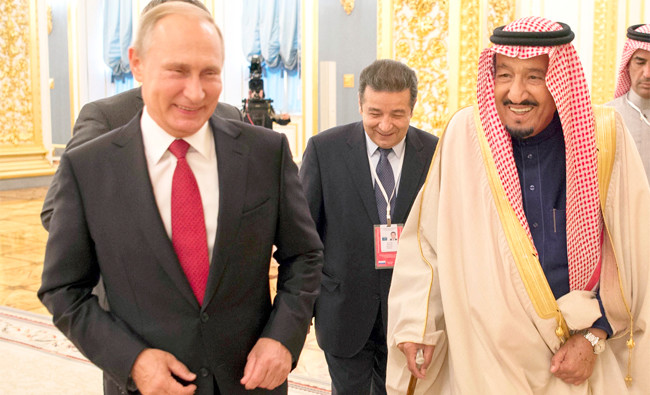
Pakistan praises Saudi Arabia over facilitating Hajj for its nationals

- Pakistani pilgrims have been arriving in Madinah since May 9 when pre-Hajj flight operations were launched
- Pakistani minister is currently visiting Madinah to oversee Hajj arrangements for his nationals
RIYADH: Pakistani Minister of Religious Affairs and Interfaith Harmony Chaudhry Salik Hussain has expressed his appreciation to Saudi Arabia for the exceptional services and facilities provided to Pakistani pilgrims who will be taking part in Hajj this year.
Minister Hussain’s remarks came in a statement delivered in Madinah, where he is currently visiting to oversee Hajj arrangements for Pakistani pilgrims, the Saudi Press Agency reported.
Pakistan has a Hajj quota of 179,210 pilgrims this year, of which 63,805 people will perform the pilgrimage under the government scheme while the rest will use private tour operators. This year’s Hajj is expected to run from June 14-19.
Pakistani pilgrims have been arriving in Madinah since May 9 when pre-Hajj flight operations were launched. Over 20,000 Pakistani pilgrims have so far arrived in Madinah under the government scheme.
The Pakistani official particularly praised the Saudi leadership for launching the Makkah Route Initiative at Karachi International Airport, mirroring the program already established at Islamabad International Airport.
Hussain was also confident the initiative will be extended to Lahore Airport in the coming year.
KSrelief continues aid projects in Sudan, Yemen and Greece

- 26 neurosurgeries were done in Sudan
- 330 relief trucks delivered 5,752 tonnes of aid to Yemen
RIYADH: The Kingdom’s aid agency KSrelief continued its projects in Sudan, Yemen, and Greece.
In Sudan, KSrelief implemented a medical volunteer project for neurosurgery and spine surgery from May 12 to May 17.
About 15 volunteer specialists from various medical fields assisted in performing 26 surgeries, the Saudi Press Agency reported.
In Yemen, KSrelief provided a convoy of 330 relief trucks, which delivered over 5,752 tonnes of critical supplies to people across 14 Yemeni governorates.
The aid included food, medical supplies, and shelter materials.
Additionally, KSrelief donated 10 tonnes of dates to Greece, which were presented by Saudi Ambassador to Greece Saad Al-Ammar to Athens.
How forest conservation is helping Saudi Arabia achieve its green objectives

- By planting trees and protecting forests, the Kingdom promotes biodiversity and sustainable development
- Forests provide habitats for hundreds of animal species and play a pivotal role in combating climate change
JEDDAH: With its low annual rainfall, much of Saudi Arabia’s vast landscape is covered by desert, broken by occasional oases. In its mountainous regions, valleys, and along its coastline, however, the Kingdom is home to multiple forest ecosystems.
Forests play a pivotal role in combating climate change by acting as carbon sinks — storing carbon both above and below ground, thereby extracting it from the atmosphere, where it would otherwise contribute to the greenhouse effect.
Their significance in climate change adaptation and mitigation is also underscored by their role in creating local microclimates, providing habitats for a wealth of biodiversity, locking in freshwater resources, and preventing flash floods, landslides, and soil degradation.
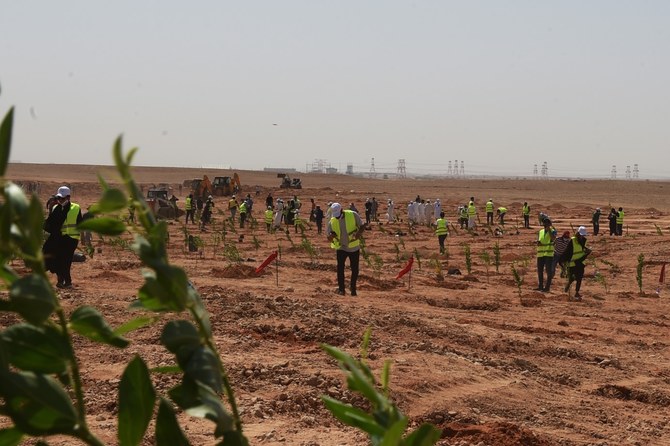
Saudi Arabia’s National Center for Vegetation Cover Development and Combating Desertification is at the forefront of implementing the Kingdom’s strategic goals outlined in Vision 2030.
“Forests play a crucial role in mitigating climate change,” Samir Malaika, assistant director-general of the general administration of forests at NCVC told Arab News. “Saudi Arabia’s dry climate and geography hinder its efforts to conserve forests and promote plant growth.
“With most areas receiving minimal rainfall, forests struggle to thrive. The escalating impact of climate change exacerbates environmental stressors, hampering forest growth and regeneration efforts.”
The NCVC aims to elevate living standards by reducing pollution and facilitating the restoration of degraded environments. It is also committed to building resilience against natural hazards and defenses against harmful pests that could pose risks to vegetation.

Simultaneously, it prioritizes the sustainable development of the Kingdom’s natural resources. With seven ongoing initiatives, it aims to ensure the responsible and lasting utilization of resources in line with the nation’s sustainability objectives.
Among the center’s key initiatives under the Saudi Green Initiative is a scheme to plant some 10 billion trees — representing a significant step in the Kingdom’s reforestation effort.
The initiative for forest management and sustainable development by 2030 underscores a long-term commitment to nurturing and preserving woodland environments.
The phased approach to preserving and restoring vegetation in pasture areas reflects a strategic focus on addressing the specific ecological challenges faced by different ecosystems.
Opinion
This section contains relevant reference points, placed in (Opinion field)
Furthermore, the initiative for developing vegetation and infrastructure for 50 national parks highlights the importance of creating protected natural spaces while promoting biodiversity and ecotourism.
Moreover, the initiative to plant 7 million wild trees in royal reserves demonstrates a targeted effort to enhance the natural habitats within these pristine areas.
Engagement by the public and private sectors in vegetation development and combating desertification underscores the collaborative approach needed in order to achieve sustainable environmental goals.

By harnessing the collective resources and expertise of various stakeholders, these initiatives aim to create a resilient and thriving ecosystem that benefits both present and future generations.
According to Malaika, Saudi Arabia boasts a forest coverage spanning approximately 2,768,050 hectares, primarily concentrated in the southern and southwestern regions, along riverbeds, and on the coastlines of the Red Sea and the Arabian Gulf.
These forest ecosystems are categorized into three primary types: mountain, valley, and mangrove.
Mountain forests
Mountain forests are predominantly located in the region spanning the Hijaz Mountains in Taif to Jazan in the south. These areas have neutral soil acidity and receive the highest rainfall and humidity levels, particularly evident in the southwest with denser forest cover.
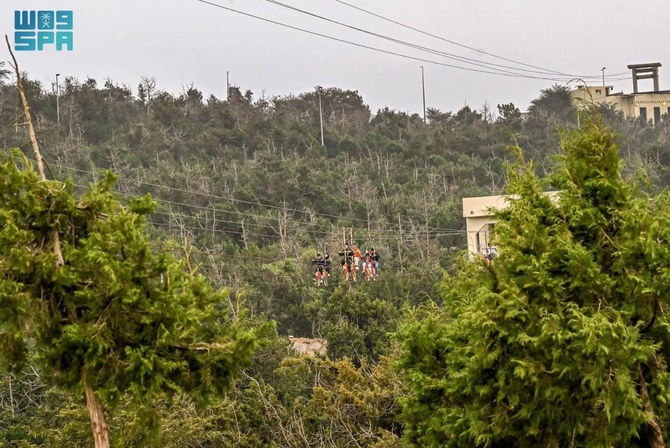
Forests are made up of several Juniperus plant species, typically found at altitudes of 2,000 meters and above. Additionally, Olea chrysophylla forests, characterized by wild olive trees with golden leaves, thrive at altitudes of 1,500 to 2,000 meters.
At lower altitudes, between 1,000 to 1,500 meters, Acacia plant species dominate the landscape.
Notably, terraced agriculture is a common feature of mountainous regions, facilitating crop fruit tree cultivation while aiding in water retention and soil protection. However, improper management can lead to land degradation, adversely affecting the surrounding forests.
DID YOUKNOW?
• Saudi Arabia is home to more than 63 unique ecosystems, ranging from mountainous regions to coastal lowlands.
• The Kingdom boasts a diverse array of wildlife, including 78 terrestrial mammal species and 499 species of bird.
• Coral reefs in Saudi Arabian waters host an impressive 266 species, contributing to marine biodiversity.
• With more than 6,500 species, Saudi Arabia’s invertebrate population testifies to the richness of its ecosystems.
• Saudi Arabia boasts three distinct forest ecosystems: mountain forest, valley forest, and mangrove forest.
Valley forests
Saudi Arabia’s topography features 179 valleys distributed across the country. Valley forests, mainly situated in semi-arid regions, are characterized by species such as Acacia ehrenbergiana, Acacia tortilis, Maerua crassifolia, several species of Commiphora, and Salvadora persica.
Additionally, oases and valleys are abundant with various Acacia species, Ziziphus spina-christi, Salvadora persica, Haloxylon persicum, trees, shrubs, and Hyphaene thebaica.
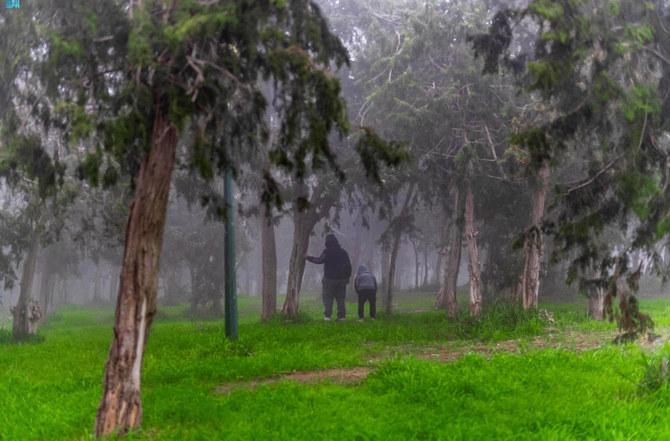
Mangrove forests
Mangroves and coastal ecosystems tolerant to saltwater are predominantly located along the Red Sea coast, with other stretches found along the Arabian Gulf coast.
Despite the lack of comprehensive forest data, studies indicate significant degradation of the mangrove ecosystem.
Avicennia marina is the most prevalent species in mangrove forests, with Rhizophora mucronata being less common.

Besides these natural forests, the Kingdom is also host to many urban and cultivated woodlands in its parks and residential neighborhoods, planted to provide shade, reduce temperatures, and beautify city streets.
Despite the Kingdom’s diverse ecosystems, it faces significant challenges in preserving and expanding its forests, including limited resources, poor local management, insufficient nursery production to meet seedling demand, a lack of awareness about dumping and unauthorized grazing, and other irresponsible human activities.
The Saudi National Center for Wildlife is working to protect, develop, and restore ecosystems and biodiversity around the Kingdom, in addition to addressing risks related to plant and animal life.
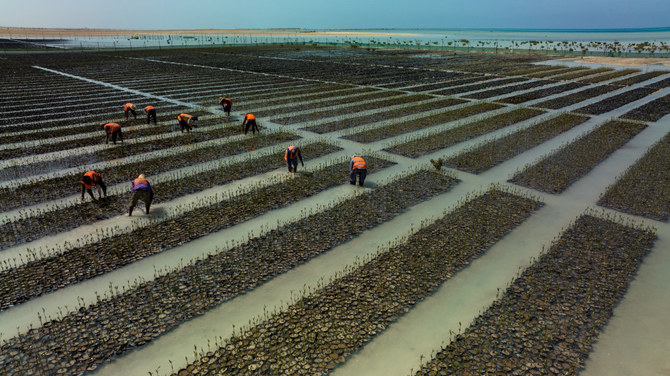
According to Abdulmanea Al-Qahtani, invertebrates department director at the NCW, the Kingdom has 63 distinct ecosystems, encompassing a diverse range of landscapes, including mountains, plains, deserts, valleys, forests, seas, wetlands, plateaus, coastal areas, and marshes, all teeming with biodiversity.
The Kingdom is home to 78 species of terrestrial mammal, 499 species of bird, 136 species of reptile, seven species of amphibian, and more than 6,500 species of invertebrate.
In its waters, the Kingdom also offers habitats to 19 species of marine mammal, eight species of freshwater fish, 1,248 species of saltwater fish, and 266 species of coral
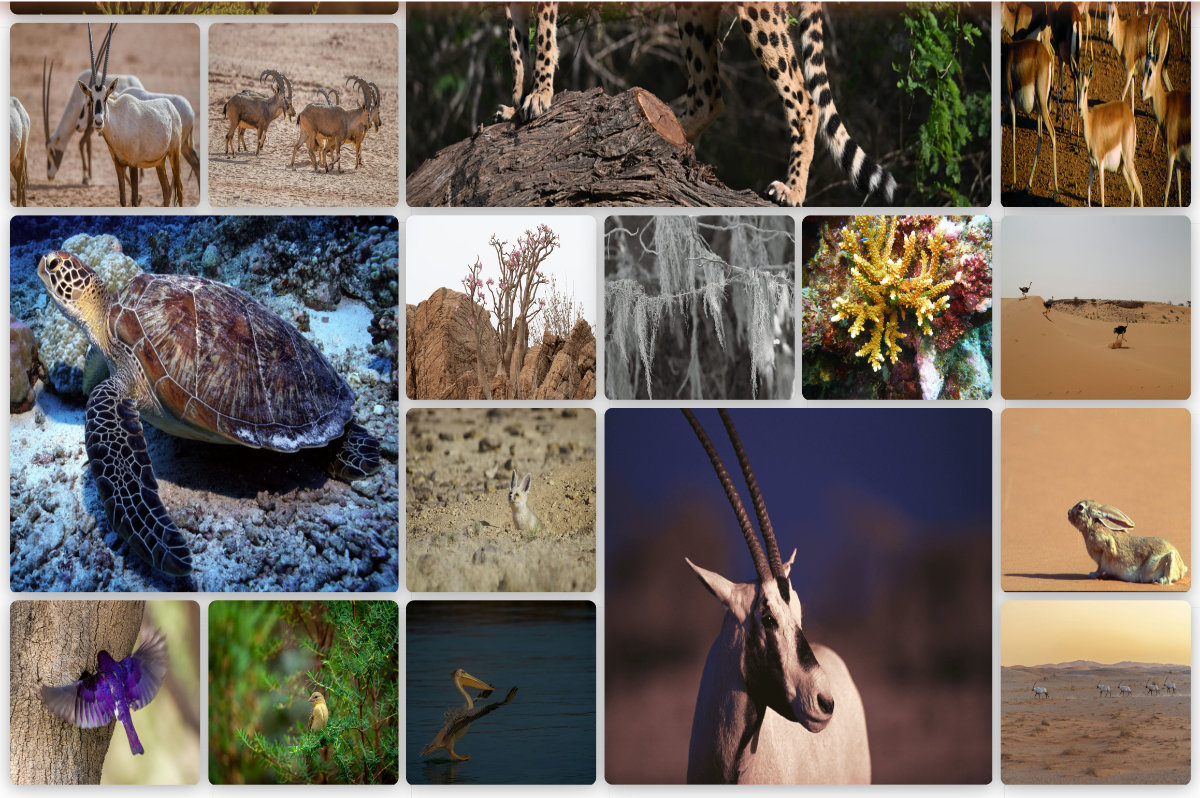
The Saudi Green Initiative, launched by Crown Prince Mohammed bin Salman in 2021 under the Vision 2030 framework, aims to tackle threats to this rich biodiversity and foster sustainable development.
Key goals include transitioning to a sustainable economy by reducing carbon emissions, boosting renewable energy production, and bolstering conservation efforts.
Additionally, the initiative aims to enhance environmental protection, promote green technologies, and create green jobs to drive economic diversification and growth.

Saudi fund signs two loan agreements, inaugurates Hulhumale Island development in Maldives

- Al-Marshad participated in the partial inauguration of the Hulhulmale Island Development Project
MALE: CEO of the Saudi Fund for Development Sultan bin Abdulrahman Al-Marshad signed on Friday two development loan agreements with the Maldives’ Minister of Finance Dr. Mohammed Shafiq. These agreements will contribute to financing the Velana International Airport development project with a value of $100 million and the healthcare sector development project in the Maldives with a value of $50 million, provided by fund.
Additionally, Al-Marshad participated in the partial inauguration of the Hulhulmale Island Development Project, which the SFD is contributing to financing through a soft development loan worth $80 million. The event was also attended by Saudi Ambassador to the Maldives Matrek bin Abdullah Al-Ajalin.
King Salman issues royal order to promote 26 judges

RIYADH: King Salman issued a royal order on Friday to promote 26 judges at the Board of Grievances, Saudi Press Agency reported.
President of the Board of Grievances and Administrative Judicial Council Sheikh Khalid bin Mohammed Al-Yousef said that the royal order confirmed the keenness of the Kingdom’s leadership to support the judiciary to develop its performance and achieve quality and efficiency.
Earlier this month, the king issued a royal decree on Saturday to appoint 261 investigative lieutenants at the Ministry of Justice’s Public Prosecution.









